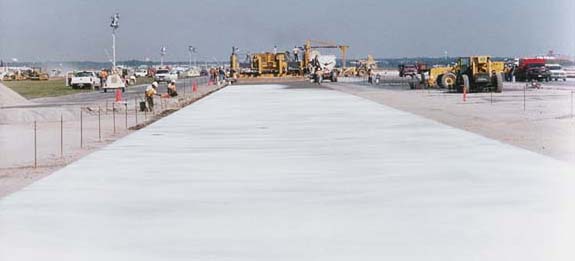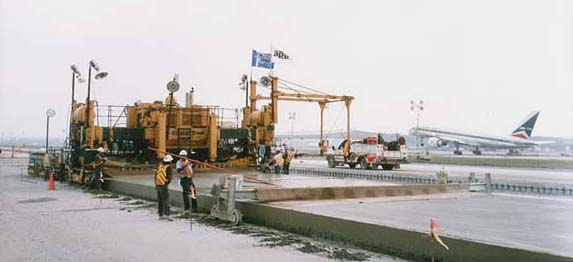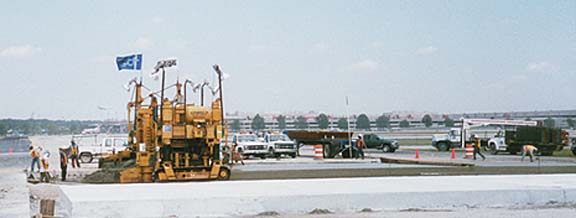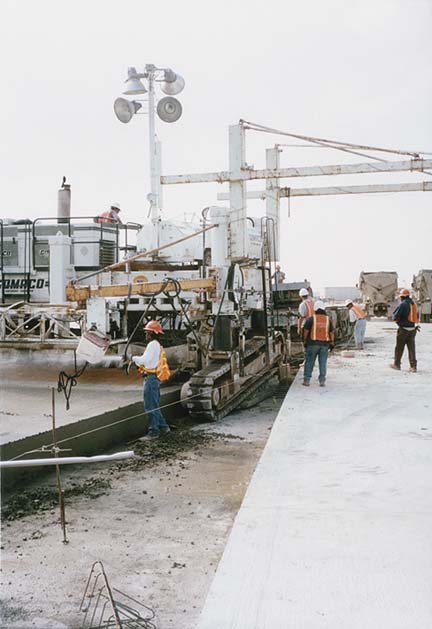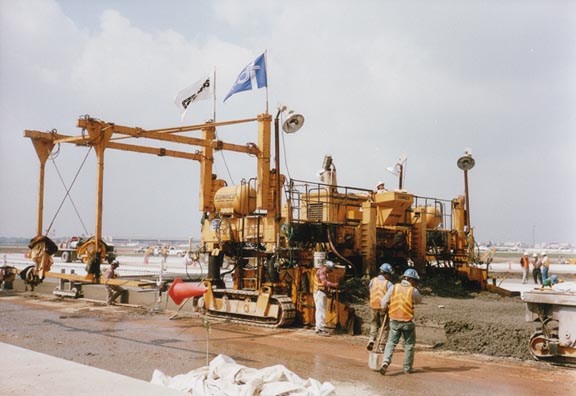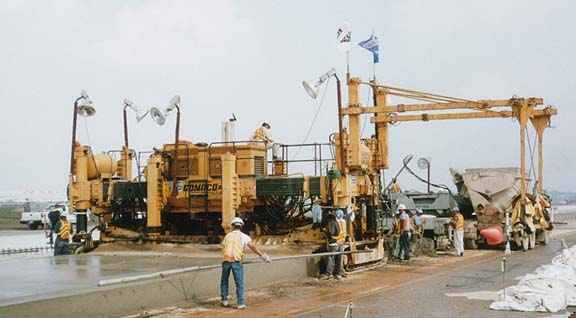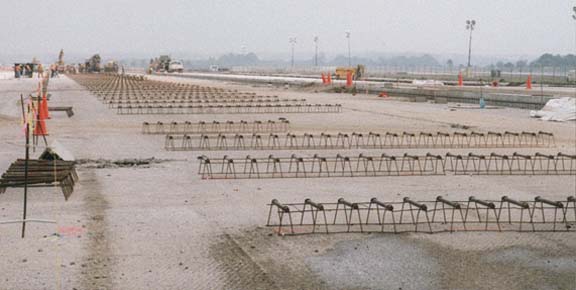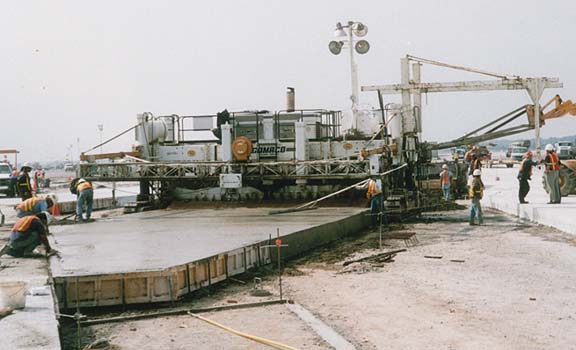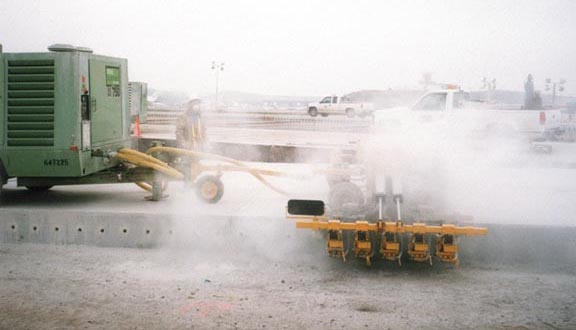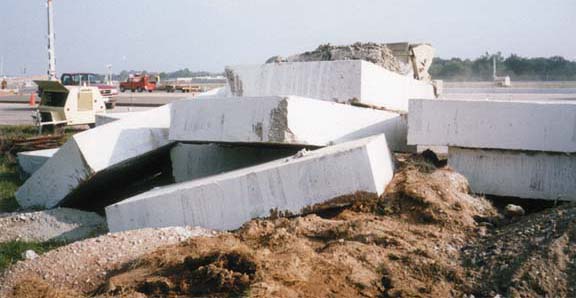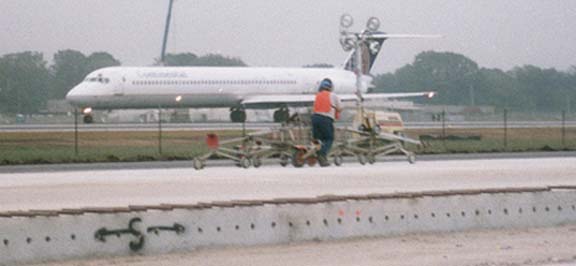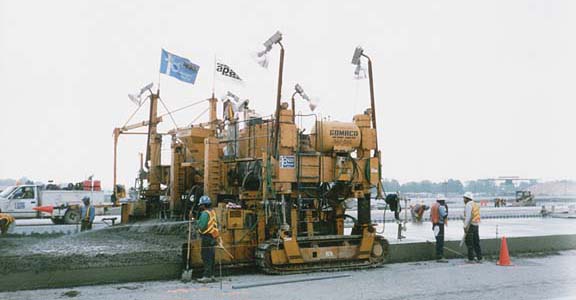GOMACO World Index --- GOMACO World 27.4 - January 2000
33 Days
Fifty-two million dollar projects aren't uncommon in today's construction industry. Consider the fact that this is an airport paving project and involved the complete removal and rebuilding of Runway 9R-27L, the southern-most runway at the Hartsfield Atlanta Airport, while maintaining air traffic at all times and the difficulty increases.
Deadlines are also a common practice, and associated with deadlines are incentives and penalties. The penalty for missing this deadline would have been $175,000 per extra day.
Perhaps the thing that makes this story really interesting is when you mention the scope of the project. A joint venture of companies completed a runway that was 46m (150 ft) wide and 2743m (9000 ft) long. The majority of it was 457mm (18 in) thick with 572mm (22.5 in) thickened edges on approximately 152mm (six inches) of cement-treated base (CTB) and 152mm (six inches) of soil cement.
Impressive figures to say the least. Here's the kicker... the Hartsfield Atlanta International Airport, the busiest commercial airport in the world, required the paving project be completed in 35.5 days.
It was finished in 33.5 days.
It might be easiest to explain this project by starting from the very beginning. The original runway was built by Ballenger Paving Company in 1972. The overall construction was completed in a seven month time period. It was 406mm (16 in) deep with 508mm (20 in) thickened edges. Unfortunately, the runway had outlived its life many times over and was in need of replacement.
A four-way joint venture team of contractors was assembled to replace the aging runway. They included APAC-Georgia Inc.; C.W. Matthews Contracting Company, Inc.; Swing Construction Company; and E.R. Mitchell Construction Company. APAC had two of its paving divisions, Ballenger Paving and Southern Roadbuilders Concrete Paving, on the project.
"We had an initial build-up period of approximately 60 days to mobilize and get ready to go: stockpile materials, put our equipment together, and build haul roads," Robert McCord, Vice President in charge of operations for APAC-Georgia, Ballenger Paving Division, said. Ballenger hauled in approximately 200 truckloads of equipment during the 60-day build up.
During construction of the adjacent Taxiway R earlier this year, it was determined that it would be used as a temporary runway during the reconstruction of 9R-27L. While Ballenger Paving was constructing Taxiway R, the alignment and grade was adjusted, the pavement was widened and grooved to meet runway criteria. Afterwards, during the 60-day build up, Taxiway R was lit, re-signed and repainted to become temporary runway 10-28.
The countdown began on September 18, 1999, at 10:30 p.m. when E.R. Mitchell Construction Company started removal of the existing runway. "The pavement was sawed into 3.81 by 2.29m (12.5 by 7.5 ft) panels and lifted out with six Cat 345 Excavators with slab crabs," McCord said. "Approximately 40 semi-tractor trailers with flatbeds were running around the clock." In less than seven days, during two phases, 167,220m2 (200,000 yd2) of runway was sawed, removed and hauled away. Presawing of the slabs had started 14 days earlier during the 60-day mobilization period.
Grade adjustments were made by C.W. Matthews Contracting Company after the pavement was removed. The subgrade was prepared in one of two ways. If the grade was too high, the existing CTB was profile milled. If it was too low, an asphalt overlay was placed on top of the CTB.
Paving on the project began three days after the start of the removal of the existing runway. Three GOMACO GHP-2800s were used to pave the project.
"We basically shut our whole division down to come here and build this," McCord said. "We have four crews here from Ballenger Paving Division, two mainline paving crews and two rehab crews." They brought their two GHP-2800s with them. Two GOMACO GP-2500s were also at the airport on a stand-by basis but were not used.
"Southern Roadbuilders sent one of their paving crews down here and one of their GHP-2800s too," McCord said.
Two of the paving crews concentrated on the runway mainline paving. The third crew mainly did high speed taxiways and tie-ins but all of the crews paved on the runway at one time or another.
The 46m (150 ft) wide runway was placed in six passes with the GHP-2800s. The new slab is 457mm (18 in) deep with thickened edges that are 572mm (22.5 in).
The 650 flex mix was designed in-house by APAC's own Materials Services Lab.
Three Rex Model-S central mix plants were on-site mixing the concrete. Approximately 45 Maxon side-dump trucks hauled concrete to the three different paving sites.
Concrete slump ranged from 13 to 32mm (.5 to 1.25 in). Joint spacing was 7.62 by 7.62m (25 by 25 ft).
The slab was straight edged and a burlap drag finish was applied. The curing compound was hand sprayed.
Seven 5-gang drills were on site to drill the side edges of the slabs. Bars 38mm (1.5 in) in diameter and 762mm (30 in) long were epoxied into the drilled holes. "This airport has never really been a big advocate for implanting or inserting," McCord said. "The spec is drill and epoxy and use dowel baskets."
Rideability was constantly measured using a profilograph. The project specifications required a rideability measurement of 178mm (seven inches). Ballenger and Southern Roadbuilders averaged 84mm (3.3 in).
One of the final steps was grooving the runway. FAA standard groove is 6mm (.25 in) depth by 6mm (.25 in) width by 38mm (1.5 in) center-to-center spacing. Grooves were sawed in perpendicular to the direction of landing aircraft.
The paving project itself was only one of the numerous challenges on this job. The weather and airport safety and security requirements created additional challenges.
Ballenger and Swing Construction Company worked with airport officials to develop some creative and time saving solutions.
"We did a lot of unique things on this project that I've never seen done before," McCord said.
Airports have strict badging requirements and employee backgrounds have to be verified before receiving a badge. A chain-link fence was set up around the perimeter of the work area. With the fence up, the work area was considered outside of the airport operation area and alleviated some of the badging requirements. Security guards were stationed wherever the fence had an opening for air or construction traffic.
Hauling concrete from the batch plant to the job site could have been a problem too. Trucks had to cross a taxiway in order to get to and from the site. To solve the problem, people from the air traffic control tower manned cars at the intersection of the taxiway and haul road. The intersection was either a taxiway for air traffic or a haul road for the construction site, depending on the way the vehicles were parked.
One of the biggest obstacles was Mother Nature. "The good Lord saw fit to challenge us," Lee Powell, President of Ballenger Paving, said. "In the first 10 days of work, we had five days of rain." The rain just kept coming, 13 of the 33 days were wet ones. With a deadline to meet, they took the proper precautions and paved through parts of it.
The sheer size of the project and the manpower it took to accomplish it could have been a major problem, but Ballenger and its officials were prepared. All of Ballenger's project managers were on site helping with the various aspects. They also called in their estimators to serve as coordinators with the survey crews and electricians.
"Planning, planning, planning, communication, communication, communication and then execution, execution, execution," Powell said. "You can have the best plan in the world but if you can't communicate it, it won't work."
By the time paving was completed, 84,101m3 (110,000 yd3) of concrete had been placed with three GHP-2800s. Eight hundred and thirty-two in-pavement or taxiway lights were paved over or around. Over 60,000 holes were drilled and dowels epoxied into the pavement edge. The numbers are mind boggling and it's even more spectacular with a 35.5 day deadline.
A lot of the credit for the project's success was accredited to the workers involved. "All of our people, as well as our joint venture partners' people, went above and beyond," McCord said. "They went until they couldn't go anymore and then they came back the next day and went again."
"The whole project was a team effort and could not have been accomplished without all of the team members being open to unique, innovative ideas and construction methods. These team members also included Dan Molloy of the city of Atlanta Department of Aviation, Frank Hayes of Aviation Consulting Engineers, and Mike Powderly of Delta Airlines.
"Without these three individual's joint commitment and the organizations they represent," according to Buddy Jump, Vice President of C.W. Matthews Contracting Company, and echoed by McCord, "we could not have accomplished the impossible, especially when you consider the rain days."
The new runway was opened to air traffic October 22, 1999, five days after paving was completed. Thirty-three and one-half days after the first piece of the old runway was removed. Two days ahead of the 35.5 day deadline and six million dollars under budget.
Subscribe to Receive GOMACO World Magazine
